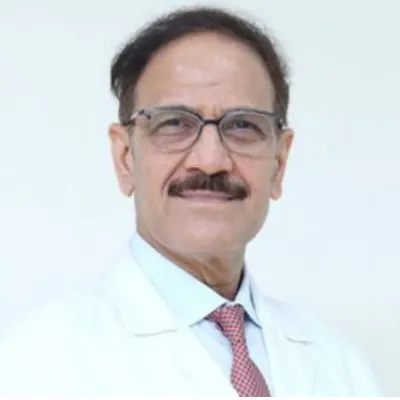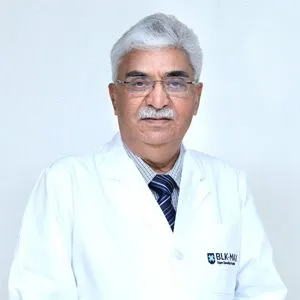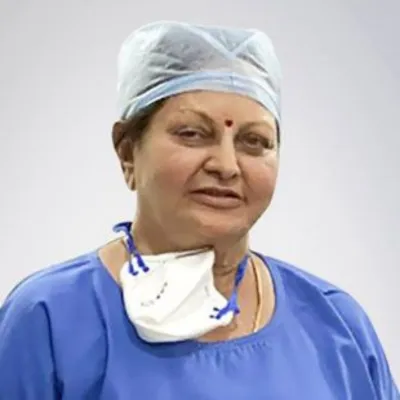Best Cardiologists in Artemis Hospital Gurgaon
 10 December,2025
Read More
10 December,2025
Read More
Starting From: USD 3000-5500
Procedure Type: Surgical Procedure
Hospitalization Days: 2-3 Days
Procedure Duration: 2-4 Hrs
Recovery Time: 4-6 Weeks
Success Rate: 95%
Permanent Pacemaker is affordable in India. The cost of Permanent Pacemaker in India lies between USD 3000-5500. The exact procedure price depends on multiple factors such as the surgeon's experience, type of hospital, severity of the condition, patient's general condition,�etc.
The surgery involves implanting a pacemaker in the chest to regulate irregular heartbeats (arrhythmia). The pacemaker is a small, life-saving device that maintains a steady heart rhythm, ensuring proper blood circulation and overall well-being. The pacemaker sends electrical impulses to the heart muscle to ensure a constant heart rate and rhythm.
India has become a pioneer destination for pacemaker surgery. The country has cutting-edge technology, internationally accredited hospitals, and highly skilled cardiac specialists. It provides safe, reliable, and affordable pacemaker costs in India for both domestic and international patients.
Your doctor may recommend a temporary external pacemaker in cases of short-term heart rhythm issues. This noninvasive device helps stabilise the heartbeat before considering a permanent solution.
When it comes to permanent implantation, there are different types of pacemakers available:
Most pacemaker implantations are performed using minimally invasive procedures, ensuring quicker recovery and minimal discomfort. The pacemaker surgery cost in India varies depending on the type of device and the hospital facility.
A pacemaker surgery is generally indicated for people suffering from the following:
1. Bradycardia Patients: A pacemaker may benefit individuals with a slow heart rate (bradycardia) due to conditions like sinus node disease or heart block.
2. Atrioventricular (AV) Block Patients: Those with symptomatic AV block, particularly second or third-degree blocks, may require a pacemaker to maintain a stable heart rhythm.
3. Heart Failure Patients: Biventricular pacemakers are recommended for patients with severe heart failure to synchronise ventricular contractions and improve heart function.
4. Symptomatic Tachy-Bradycardia Syndrome: Patients experiencing both fast and slow heart rhythms may benefit from pacemaker therapy
5. Postoperative AV Block: Patients with persistent AV block after cardiac surgery may need a pacemaker
It is recommended to consult a cardiologist to determine whether you are a suitable candidate for this surgery and to understand the permanent Pacemaker cost in India.
The pacemaker surgery cost in India varies depending on several factors. Below are approximate ranges:
Note: The cost of a single pacemaker device ranges from approximately USD 490 to USD 660.
These figures generally cover routine pacemaker surgery performed without complications.
Several elements can push your pacemaker surgery bill higher or lower. The main factors affecting Pacemaker cost in India are as follows:
Here is an overview of the cost of Pacemakers in India in major cities. USD equivalents are approximate and subject to currency fluctuations.
|
City |
Min Cost (INR) |
Max Cost (INR) |
Min Cost (USD) |
Max Cost (USD) |
|
New Delhi |
INR 2,40,000 |
INR 5,90,000 |
USD 2,758 |
USD 6,900 |
|
Mumbai |
INR 2,50,000 |
INR 4,50,000 |
USD 2,872 |
USD 5,170 |
|
Bengaluru |
INR 2,30,000 |
INR 4,60,000 |
USD 2,643 |
USD 5,285 |
|
Chennai |
INR 2,60,000 |
INR 4,75,000 |
USD 2,987 |
USD 5,458 |
|
Hyderabad |
INR 1,10,000 |
INR 3,25,000 |
USD 1,271 |
USD 3,734 |
|
Kolkata |
INR 80,000 |
INR 1,00,000 |
USD 409 |
USD 1,155 |
|
Pune |
INR 80,000 |
INR 2,00,000 |
USD 919 |
USD 2,298 |
|
Ahmedabad |
INR 90,000 |
INR 2,00,000 |
USD 1,040 |
USD 2,298 |
|
Chandigarh |
INR 80,000 |
INR 2,50,000 |
USD 919 |
USD 3,000 |
|
Gurugram |
INR 90,000 |
INR 2,00,000 |
USD 1,040 |
USD 2,298 |
Metros such as Delhi, Mumbai, Hyderabad, and Bengaluru generally have broader cost brackets because of a higher density of high-end hospitals. Pacemaker surgery costs in Kolkata and Ahmedabad can offer slightly lower prices while still delivering quality care. It is always recommended to consult a healthcare provider for precise PPM cost in India.
Medical tourists often compare multiple destinations for the best combination of cost and expertise. Below is a generalized comparison:
|
Country |
Approximate Cost Range (USD) |
|
India |
USD 3,000 – USD 5,500 |
|
United States |
USD 10,000 – USD 50,000 |
|
United Kingdom |
USD 15,000 – USD 30,000 |
|
Thailand |
USD 6,000 – USD 14,500 |
|
Turkey |
USD 6,000 – USD 14,000 |
|
UAE |
Up to USD 7,000 |
India's balance of affordability, advanced hospital infrastructure, and highly trained specialists for pacemaker surgery sets it apart.
There are additional costs apart from the surgery procedure, which are mentioned below:
1. Consultations & Diagnostic Tests:
2. Other Evaluations:
Most major hospitals accept domestic and international insurance for Pacemaker implantation costs in India. Since 2019, health insurance coverage for pacemaker costs in India has improved significantly. Many insurers now cover the procedure if it's medically necessary due to conditions like arrhythmia or heart failure. However, eligibility depends on your policy terms—pre-existing conditions and waiting periods can play a role.
Indian insurance providers include pacemaker implantation under inpatient hospitalisation benefits, covering surgery, hospital stay, and even the device cost in some cases. If you're an international patient, it's best to check with your insurer about medical tourism reimbursements before planning your treatment in India.
Looking to make the average Pacemaker Cost in India more affordable? Here are some smart strategies to ease the financial burden while ensuring top-quality care:
With the right approach, affordable pacemaker surgery in India can be both accessible and effective without compromising on quality.
India has emerged as a top destination for pacemaker surgery, offering world-class medical facilities and experienced cardiologists even in Tier-2 cities. Whether you are seeking emergency treatment or planned surgery, our experts will ensure seamless medical care with medical experts. We will always be with you in every step of your surgery process.
We have spent years helping patients connect with India's best cardiac specialists and hospitals. Our team will handle every detail, right from matching you with trusted surgeons to explaining the affordable Pacemaker cost in India.
We will arrange all the travel paperwork. From visa assistance to accommodation and interpreter services, we ensure a seamless experience. With us, you’re not just another patient; you’re a priority. Let us help you access world-class cardiac care in India.
Contact MediJourney today to plan your pacemaker surgery with confidence!
Answer: The cost of a permanent pacemaker operation in India typically ranges from INR 2.2 lakh to INR 4.5 lakh, depending on the hospital and city.
Answer: The approximate cost of permanent pacemaker implantation in India is INR 2.5 lakh to INR 5 lakh, inclusive of the device, surgery, and hospital stay.
Answer: Yes, costs vary by type. Single-chamber pacemakers are more affordable, while dual-chamber and MRI-compatible pacemakers are priced higher.
Answer: Yes, cities like Chennai and Hyderabad generally offer lower costs compared to metro cities like Mumbai and Delhi. Prices also vary between private and government hospitals.

Chairman
Interventional Cardiologist
BLK-Max Super Speciality Hospital, New Delhi

Director
Cardiologist, Interventional Cardiologist
Max Super Speciality Hospital, Saket, New Delhi

Chairman
Cardiac Electrophysiologist, Interventional Cardiologist
BLK-Max Super Speciality Hospital, New Delhi

Consultant
Interventional Cardiologist
Indraprastha Apollo Hospital, New Delhi

Head of Department (HOD)
Cardiologist
Nanavati Super Specialty Hospital, Mumbai

Consultant
Interventional Cardiologist
Apollo Hospital Chennai, Greams Road
Doctor of Pharmacy
Dr. Deepanshu Siwach is a skilled clinical pharmacist with a Doctor of Pharmacy degree.?He has 4+?years of experience and has worked with thousands of patients. He has been associated with some of the top hospitals, such as Artemis Gurgaon.
Dr. Deepanshu Siwach is a skilled clinical pharmacist with a Doctor of Pharmacy degree.?He has 4+?years of experience and has worked with thousands of patients. He has been associated with some of the top hospitals, such as Artemis Gurgaon....
Dr. Aseem Ranjan Srivastava is an experienced Pediatric Cardiothoracic Surgeon specializing in Minimal Access and Robotic Cardiac Surgery. He strongly recommends prompt corrective repair when possible....
The Art of Effective Communication
 10 December,2025
Read More
10 December,2025
Read More
 09 December,2025
Read More
09 December,2025
Read More
 05 December,2025
Read More
05 December,2025
Read More
 04 December,2025
Read More
04 December,2025
Read More
 27 November,2025
Read More
27 November,2025
Read More
 25 November,2025
Read More
25 November,2025
Read More